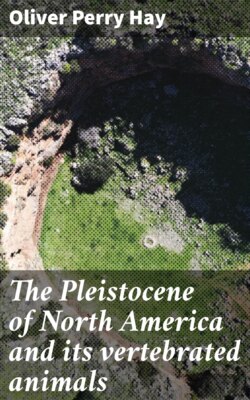Читать книгу The Pleistocene of North America and its vertebrated animals - Oliver Perry Hay - Страница 16
На сайте Литреса книга снята с продажи.
XI. The First Interglacial, or Aftonian, Stage.
ОглавлениеTable of Contents
Mention has been made of collections of fossil vertebrates which long ago were secured at Fossil Lake, Oregon, and of others along Niobrara River, near Grayson, Nebraska. Lists of the species found at each locality were given by Dr. W. D. Matthew in 1902 (Bull. Amer. Mus. Nat. Hist., vol. XVI, pp. 317–320). These deposits and animals were regarded by Cope and Marsh as belonging to the Pliocene, until G. K. Gilbert, in his work on Lake Bonneville (Monogr. I, U. S. Geol. Surv., pp. 393–402) showed that the Oregon fossils must belong to the Glacial epoch, but he referred them to a late time in this epoch, that of the last glaciation. It thus became quite impossible to determine the age of any collection of fossil vertebrates.
In 1887 (Univ. Geol. Surv. Kansas vol. II, pp. 299–308), Williston wrote:
Every fact furnished from Kansas seems to substantiate Cope’s conclusion that the Megalonyx fauna of the East and the Equus fauna of the West were contemporaneous and that both occurred during the period of depression; that is, during late Pleistocene time.
This paragraph was quoted by Osborn in 1910 (“Age of Mammals,” p. 453), who appears to agree in part with Williston, although he expressed the opinion that some of the deposits were earlier than the others. Osborn supported the view of the existence of two faunas, that of the “Equus zone” and that of the “Megalonyx zone.” The former fauna was regarded as the older, but overlapping somewhat during the “mid-Pleistocene” the Megalonyx fauna. He presented a catalogue of deposits belonging to his Equus zone (his page 453) and another of those of the Megalonyx zone (p. 467). In the latter he included deposits that he would now doubtless refer to the earliest Pleistocene, for example, the Ashley River beds.
It was necessary for the geologists to come again to the rescue of the palæontologists. They established the fact that there had passed, not a single glacial stage, but a series, and that these had been separated by corresponding interglacial stages. They were able to show also that between the drift-sheets there were to be found remnants of old gravels and fossil-bearing soils. In Iowa, through the careful researches of Calvin and Shimek, numerous remains of fossil mammals were discovered in gravels lying between the earliest drift, the Nebraskan, and the second drift, the Kansan. Among these mammals were identified horses, camels, elephants (E. columbi, E. imperator), Mylodon, Megalonyx, and a large ruminant which is certainly a species of bison. This fauna, known as the Aftonian, was correlated by Calvin with that of the Sheridan beds of Nebraska (Bull. Geol. Soc. Amer., vol. XX, p. 354). The writer has had the opportunity to study this Aftonian material (Iowa Geol. Surv., vol. XXIII), and, although it is not as abundant as might be desired, he agrees with Calvin’s correlation.
Making due allowances for environment and the hazards attending preservation and collection, the Aftonian and Sheridan fauna is practically the same as that found at Fossil Lake, Oregon. Furthermore, it may be traced along the plains into Texas and to the shores of the Gulf. Here, at or near tide-level, or not far away, may be found horses, camels, elephants (E. columbi and E. imperator), Mammut americanum, and mastodons with teeth presenting trefoils. In Texas, within a mile of the Louisiana line, Elephas imperator has been collected. The fauna reappears on the west coast of Florida; also on Peace Creek; on the east coast at Vero; at Brunswick and Savannah, Georgia; along Ashley River, near Charleston; probably also on the banks of Neuse River, 16 miles below New Bern, North Carolina; and again probably at Long Branch, New Jersey, where Megatherium has been found; and finally at Port Kennedy, on Schuylkill River, about 25 miles above Philadelphia. All along the coast, apparently from the Rio Grande to Long Branch, the localities which furnish Aftonian fossils are within a few feet of sea-level.
